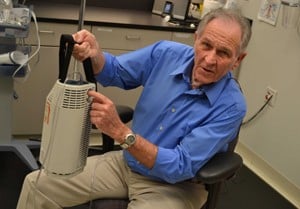Procedure Energizes Patient With Chronic Lung Disease

UAMS’ Thaddeus Bartter, M.D., explains how trans-tracheal oxygen (TTO) can help people like Bob Anderson (right) live with chronic lung diseases.
| Bob Anderson’s health was deteriorating at an alarming rate before he saw Thaddeus Bartter, M.D., at the University of Arkansas for Medical Sciences (UAMS).
Recurring bouts of pneumonia led to a lung cancer diagnosis one month after he retired, and he developed chronic obstructive pulmonary disease (COPD) and chronic bronchitis.
Radiation treatment further reduced his lung function in his upper left lobe, and he was given supplemental oxygen through a nasal tube that fastened around his ears. The device had its drawbacks; the tubing wore blisters on his nose, upper lip and ears, and it couldn’t deliver enough oxygen to allow the 67-year-old a more active lifestyle.
His oncologist in Hot Springs referred him to Bartter, who told Anderson about trans-tracheal oxygen (TTO), which delivers oxygen directly into the windpipe through a small hole in the lower part of the neck.
“By delivering oxygen directly into the windpipe, patients get a larger dose of oxygen with each breath and with less effort,” said Bartter, one of only two physicians in Arkansas providing TTO treatment. “Most patients feel better and have less shortness of breath.”

Bob Anderson’s oxygen needs are now supplied by a small portable oxygen tank, which allows him to be more mobile.
When Bartter broached the idea of the TTO procedure, Anderson researched it and decided it was the best alternative. In addition to improving his ability to breathe, the small hole in his neck can be hidden by a buttoned shirt. His oxygen needs are supplied by a small portable oxygen tank which allows him to be mobile.
Bartter performed the TTO outpatient procedure on Anderson in March. A month later, Anderson reported dramatic improvement. His oxygen use while resting decreased 75 percent, and it decreased 25 percent while being more physically active.
“I expect that my oxygen use during physical exertion will decrease even more because the TTO allows me to be more vigorous when I’m exercising,” said Anderson, who was a heavy smoker for about 35 years until he quit 12 years ago. “The exercise is toning my muscles, which decreases the need for oxygen.”
Anderson retired from the Little Rock Police Department in 1988, and he and his wife, Mary, spent 10 years as independent over-the-road truck drivers. Today Anderson enjoys gardening at his home in Oden in southwestern Arkansas and playing his steel guitar with friends and at church.
“My only regret is that I didn’t have this done a lot sooner,” he said. “I noticed that when I sleep with this I get better rest; I feel better in the morning and my energy level is better. I can do a lot more.”
Bartter provides TTO to one or two patients a month but believes there are many more Arkansans who could benefit.
“This can change peoples’ lives,” he said.
